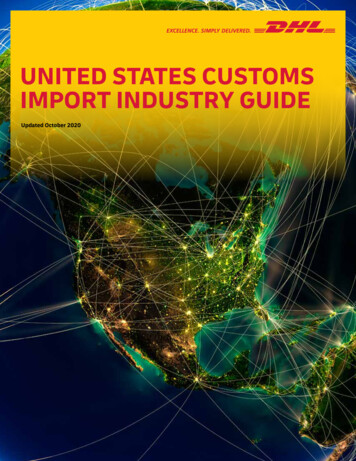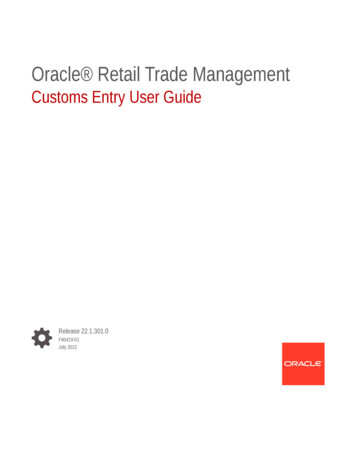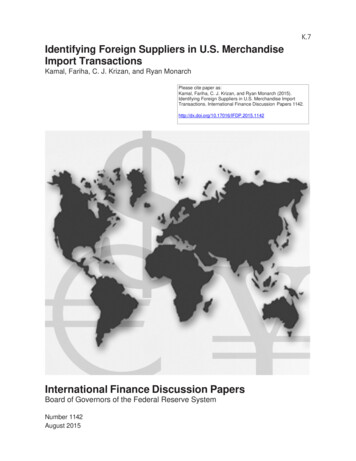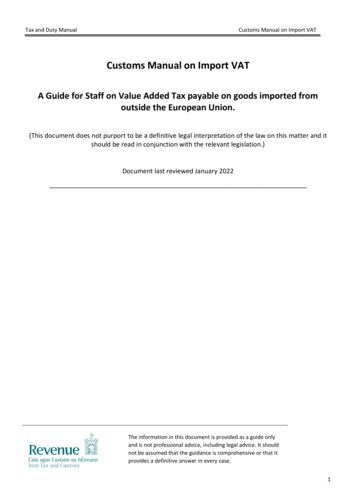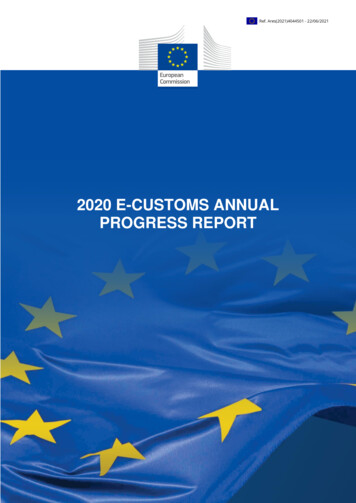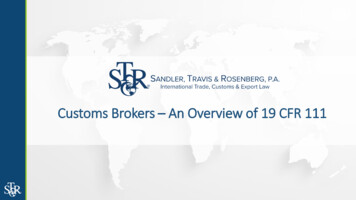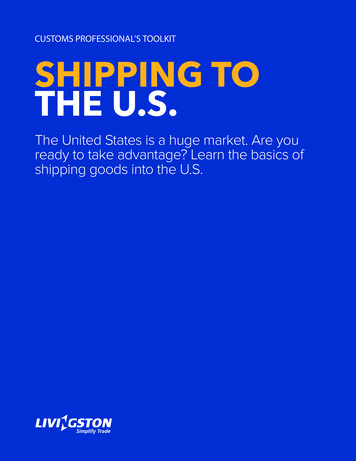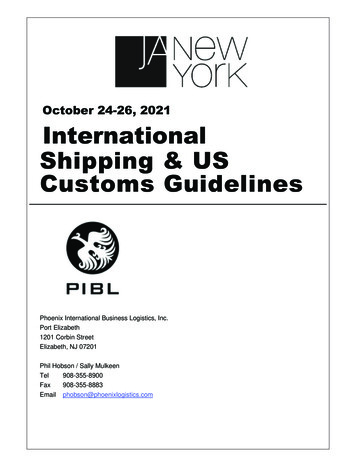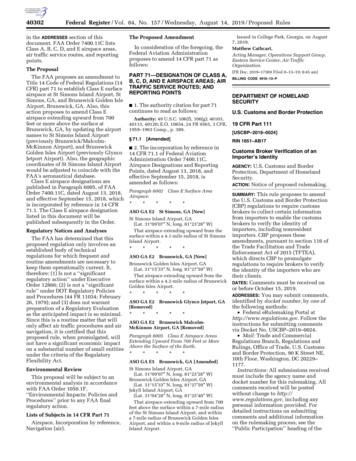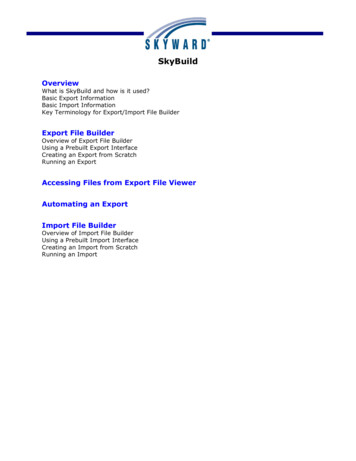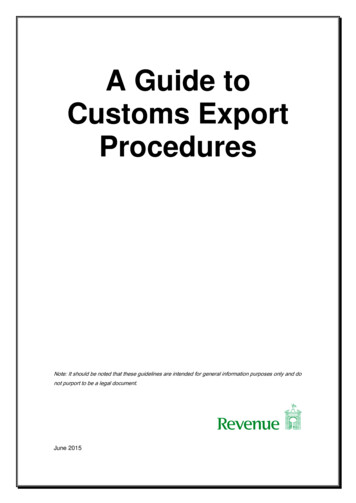
Transcription
A Guide toCustoms ExportProceduresNote: It should be noted that these guidelines are intended for general information purposes only and donot purport to be a legal document.June 2015
ContentsSection 1:Introduction . 4Who is this guide aimed at? . 4What does exportation mean? . 4Types of Export . 4Single Transport Contract (STC) . 4Why is Revenue interested in Exports? . 5What law governs customs procedures relating to exports? . 5Are there any prohibitions or restrictions on what I can export? . 5Are there any penalties for contravening export legal requirements? . 6Section 2:Export Declarations – Normal Procedures. 7General . 7What is an export declaration? . 7How do I make an export declaration? . 7When do I need an export declaration? . 7Can I use an agent to act on my behalf?. 8Section 3:Completing an Export Declaration . 9What details need to be declared? . 9What is a Commodity Code? . 9What is TARIC? . 9What if I have trouble classifying my goods? . 9What is a Binding Tariff Information (BTI)? . 10What are the benefits of BTI for Traders? . 10How do I obtain a BTI? . 10What is a Customs Procedure Code? . 10How do I calculate the value of my exports? . 11Section 4 Lodging an Export Declaration . 13At what point in the export procedure do I need to lodge the Export Declaration? . 13What are the time limits for lodgement of an export declaration? . 13What are the exceptions to the requirement to lodge an export declaration in advance? . 14Place where the export declaration should be lodged? . 14Who should lodge the export declaration? . 14Are there any fallback arrangements in place? . 15What is the significance of the date of acceptance of an export declaration? . 15Can I make an amendment to a declaration after it has been accepted? . 15What happens after my declaration has been accepted? . 15Section 5:Automated Entry Processing (AEP) . 17What is Automated Entry Processing (AEP)? . 17How do I make an electronic export declaration via AEP? . 17Section 6: Export Control System (ECS) . 18What is ECS? . 18How does ECS work?. 18Movement Reference Number (MRN) . 19Section 7: Authorised Economic Operator . 20What is an Authorised Economic Operator (AEO)? . 20Who can apply for AEO status? . 20What are the benefits of AEO status? . 20Where should applications for AEO status be submitted? . 21How long will the authorisation be valid for? . 212
Section 8: Economic Operator Registration and Identification (EORI) Scheme. . 22What is EORI? . 22How does EORI work? . 22What should a trader who has not been assigned an EORI number do? . 23Section 9:Accompanying Documents. 24What Documents need to accompany the customs export declaration? . 24What is an export licence? . 24How do I know if I need a licence? . 24Section 10: Exceptions to the general export declaration procedure . 26Are there any exceptions to the general declaration procedure? . 26What is the Local Clearance Procedure? . 26How do I apply for the Local Clearance Procedure? . 27What are the conditions of the Local Clearance Procedure? . 27What is the Simplified Declaration Procedure? . 27How do I apply to use the Simplified Declaration Procedure? . 28What are the conditions for the Simplified Declaration Procedure? . 28What is an Incomplete Declaration? . 29How do I apply to use an Incomplete Declaration? . 29What are the conditions for use of an Incomplete Declaration?. 29Section 11: Miscellaneous . 30Are there any export taxes payable? . 30Will I have to pay VAT on exports to a Third Country? . 30What are Export Preferences? . 30What is meant by the "origin" of the product/goods? . 31What is an ATA carnet?. 31What is Outward Processing? . 31How can I obtain Outward Processing Relief? . 32What is Returned Goods Relief? . 32How can I obtain Returned Goods Relief? . 32My Goods have been seized what can I do? . 33Can I appeal a decision made by Revenue?. 33Appendix 1 – Definitions . 35Appendix 2 – Further Information . 383
Section 1: IntroductionWho is this guide aimed at?This guide is for anybody, whether in business or not, who intends to send goods from Irelandout of the European Union (EU). At present there are 28 Member States of the EU as follows:Austria, Belgium, Bulgaria, Croatia, Cyprus, Czech Republic, Denmark, Estonia, Finland,France, Germany, Greece, Hungary, Ireland, Italy, Latvia, Lithuania, Luxembourg, Malta,Netherlands, Poland, Portugal, Romania, Slovakia, Slovenia, Spain, Sweden and UnitedKingdom.The guide has been designed to help you get started on exporting and to help you betterunderstand the various steps involved in the export procedure. If you are engaged in sellingproducts to customers based in a non-EU Country the information in this publication will berelevant to you.Please note that to maximise the use of this guide it should be read in conjunction with theinstructions and public notices as outlined in Appendix 2 all of which are available fordownload at www.revenue.ie.What does exportation mean?In the context of this guide, exportation means sending goods from Ireland to a countryoutside the EU.Types of ExportThere are three specific types of export:(a)Direct exports: goods leave Ireland directly for their destination outside the EU;(b)Indirect exports: goods leave Ireland, travel to one or more other Member State(s) andleave from there for their destination outside the EU; and(c)Exports made on the basis of a Single Transport Contract: although goods leaveIreland and travel to one or more other Member State(s) from which they leave for theirdestination outside the EU (in the same way as indirect exports) they are treated as ifthey are direct exports and all customs formalities are completed in Ireland at therequest of the declarant.Single Transport Contract (STC)A STC may also be referred to as a through Bill of Lading (for maritime) or a through AirWaybill (for air freight) and is used where the commercial contract of carriage is end-to-end.An example of this would be where an exporter makes a booking with their freight forwarderthe terms of which are, for example, Dublin to Shanghai. The export will not move directlybetween these locations, but may be moved using various modes of transport (including by4
road) through any route determined by the freight forwarder or ocean carrier. The precisedetails of this routing may be unknown to the exporter or declarant.Please note that it is not possible to claim STC where final exit from the EU is to be made byroad. When STC is claimed, it allows the Irish customs office to operate as both Office ofExport and Office of Exit. As a result the formalities of the Office of Exit are completed here inIreland before the export starts its journey.Why is Revenue interested in Exports?Revenue has an interest in exports for a number of reasons including:(a)Enforcing export restrictions and prohibitions;(b)Ensuring that export licensing requirements are met;(c)Ensuring that EU Regulations for export relief schemes are correctly implemented;(d)Preventing the unauthorised diversion of duty-free or VAT zero-rated goods to thehome market;(e)Ensuring that requirements for safety and security purposes have been adhered to; and(f)Collecting export statistics for the Central Statistics Office.What law governs customs procedures relating to exports?The main legal provisions for the export of goods from the EU are contained in CouncilRegulation No. 2913/92, which established the Community Customs Code and CommissionRegulation No. 2454/93, which lays down the provisions for the implementation of CouncilRegulation No. 2913/92.Are there any prohibitions or restrictions on what I can export?It is important to be aware that the exportation of certain goods may be prohibited orrestricted. This means that certain goods may not be exported at all, while other goods maybe exported only with a valid licence/authorisation. For information on goods, the exportationof which are prohibited or restricted, see Prohibitions and Restrictions. You should be awarethat certain prohibitions and restrictions apply to all goods irrespective of their destinationwhilst in the case of others there may not be a difficulty with movement within the EU.The following is an illustrative list of the types of products that are prohibited or restricted onexportation.(a)Agricultural and Food Products;(b)Cultural artefacts;(c)Drugs;(d)Weapons;(e)Counterfeit or Pirated Goods;(f)Indecent Articles, Publications, Video Recordings; and(g)CITES (Convention on International Trade in Endangered Species).5
If clarification of any matter relating to prohibitions or restrictions is required you shouldcontact Risk, Prohibitions and Restrictions Unit, Customs Procedures Branch, Office of theRevenue Commissioners, Government Offices, St. Conlon’s Road, Nenagh, Co. Tipperary at:Telephone 067 – 63376/63441, e-mail rcpr@revenue.ieAre there any penalties for contravening export legal requirements?Penalties exist where goods are being, or are intended to be, exported in contravention of anyprohibition or restriction. A person found guilty of an offence under the Customs Acts will beliable to a fine of up to 5,000 or at the discretion of the court, to imprisonment for a term notexceeding 12 months or to both the fine and imprisonment. (Customs Act 1956 as amendedby Finance Act 2010).It is important to be aware that Section 54 of the Finance Act 2011 introduced a system ofadministrative penalties for contravention of legal requirements set out in the CommunityCustoms Code and it’s Implementing Provisions. The penalties range from 100 to 2,000depending on the contravention: for example, in cases where a person does not make adeclaration, he or she is liable to a penalty of 2,000 whereas in cases in which a personmakes an incorrect or incomplete declaration, he or she is liable to a penalty of 100 perdeclarationFurther information regarding Administrative Penalties may be found on the Revenue websiteusing the following link - AEP Helpdesk Notification Ref: 012/20126
Section 2: Export Declarations – Normal ProceduresGeneralExport is one of a number of customs procedures for dealing with goods. Each suchprocedure has its own rules and those seeking to use a procedure must formally make adeclaration to Revenue for that purpose.What is an export declaration?An export declaration for customs purposes is the legal act, whereby a person indicates in theprescribed manner and form, a wish to place goods under the export procedure.How do I make an export declaration?Since 1 July 2009 any customs declaration for export must be lodged electronically, viaRevenue’s Automated Entry Processing (AEP) system, which is described later in this guide.The official format for making a declaration to Revenue to place goods under the exportprocedure is the Single Administrative Document (SAD). This format is used throughout theEU to declare goods. The SAD gives all the information needed for a complete picture ofwhat the goods are and what is happening to the shipment. The declaration contains 54boxes, but not all of them need to be completed. The details of which boxes should becompleted and why, are given in the AEP Trader Guide. Since 1 July 2009 all forms ofcustoms declarations for export must also contain the particulars laid down for suchdeclaration in Annex 30A to the Community Customs Code Implementing Provisions (CCIP)so that additional risk analysis for safety and security purposes can be undertaken byCustoms Administrations as part of the standard formalities at export.When do I need an export declaration?Revenue will require an export declaration for:(a)Goods exported to a non-EU country; or(b)Goods bound for any of the special territories of the EU which are part of its customsterritory but are not part of its fiscal territory; or(c)CAP goods exported to an entitled destination in accordance with the provisions ofCommission Regulation (EEC) No. 612/09Goods delivered tax exempt as aircraft andship supplies, regardless of the destination of the aircraft or ship.You do not need to make an export declaration for goods of Irish origin, or of EU origin, whichare in free circulation in Ireland, dispatched to other EU Member States.It should also be noted that where EU goods are being dispatched directly to a territorybelonging to the EU’s customs territory but not to its fiscal territory the export declaration need7
not contain the data for safety and security as specified in Annex 30A. A similar situationapplies in respect of exports to Norway, Switzerland and Liechtenstein.Can I use an agent to act on my behalf?You can appoint a representative to act on your behalf. The type of representation may beeither direct or indirect. Direct representatives act in the name of, and on behalf of, anotherperson. Indirect representatives act in their own name but on behalf of another person.If you appoint an agent to act on your behalf this is normally as a direct representative i.e. theagent makes the declaration on your behalf (as the principal) acting in your name, meaningyou are deemed the declarant and are therefore liable for any Customs debt.8
Section 3: Completing an Export DeclarationWhat details need to be declared?As the minimum data requirements for any type of customs declaration are specified inlegislation, the absence of required data from such a declaration will produce a rejection fromthe AEP system. It is important to remember that a rejection will only show the first error thatthe AEP system encounters. If there are further errors, the AEP system will reject them one ata time.Details to be submitted include the origin of goods, the country to which the goods are beingsent, Commodity Codes, Customs Procedure Codes and values. The exact requirements foreach customs procedure are specified in the AEP Trader Guide.What is a Commodity Code?The Commodity Code for exports is a ten-digit number, which equates to a description of theitem. No matter how diverse or obscure, all types of goods will have a unique CommodityCode. A Commodity Code is required on all normal export declarations and may also berequired on certain simplified declarations at export (see Section 10). It is entered in Box 33 ofthe SAD. Commodity Codes are set out in TARIC.What is TARIC?TARIC, is a database managed by the European Commission in Brussels and used by allMember States which is updated daily and has a simulation date facility, which allows theuser to search for a rate of duty on any given date. For classification of goods, commoditycode numbers, rates of duties for any given date see Schedule of Customs Duties, which isa direct link to TARIC. In addition, TARIC provides for classification of all goods by means ofthe description (typing in the description of the goods) or the browse facility (which providesfor viewing all sections/chapters etc.) .It is essential that you keep up-to-date with changes in Commodity Codes, rates of duty andRegulations related to your products.What if I have trouble classifying my goods?If after studying TARIC you are unable to properly classify goods for Customs purposes orhave any queries regarding the classification of your goods, you can contact Classification,Origin and Valuation Unit, Customs Procedures Branch, Office of the RevenueCommissioners, Government Offices, St. Conlon’s Road, Nenagh, Co. Tipperary. The Unitwill offer an opinion on the classification of your product. You can also apply for a BindingTariff Information (BTI), which is a tariff classification decision that is legally bindingthroughout the EU. The Unit can be contacted on 353 (0) 67 63244 between 9.15 - 17.309
Mondays – Thursdays and 9.15 – 17.15 Fridays (except Public Holidays) or by email attarclass@revenue.ie.What is a Binding Tariff Information (BTI)?BTI is an EU-wide system that provides traders with tariff classification decisions that arelegally binding throughout the EU. BTI decisions are issued by the Customs administrations inthe various Member States.The BTI database may be accessed at the following link - BTI DatabaseWhat are the benefits of BTI for Traders?The benefits of BTI for traders are as follows:(a)Legal certainty regarding tariff classification decisions;(b)Uniform application of the rules of classification throughout theEU;(c)If a BTI is invalidated due, for example, to a change in EU legislation, traders may beentitled to a period of grace in order to complete any binding contracts entered into onthe basis of that BTI; and(d)Traders will be informed if any classification changes occur which affect their BTI.How do I obtain a BTI?Applications should be forwarded to Classification, Origin and Valuation Unit, CustomsProcedures Branch, Office of the Revenue Commissioners, Government Offices, St. Conlon’sRoad, Nenagh, Co. Tipperary or by e-mail at tarclass@revenue.ie.Application forms may be accessed at the following link - BTI application formApplications should only be made where an actual commercial transaction is proposed andshould only be in respect of one type of goods e.g. goods, product or item relating to a singleCommodity Code.What is a Customs Procedure Code?The Customs Procedure Code describes the procedure and/or the economic regime underwhich the goods are to be exported. It is required on all export declarations and is to beentered in Box 37 of the SAD. A list of procedure codes for exports can be found in Appendix4 of the AEP Trader Guide. In addition to a straightforward sale to a customer overseas, therecan be a number of reasons why goods are exported. Examples include:(a)Goods going out on long-term loan/hire, to be returned eventually;(b)Goods being temporarily exported for a repair to take place; and(c)Goods being re-exported after processing by an Irish/EU company.10
Goods being exported temporarily may be eligible for relief from duty when they aresubsequently re-imported to Ireland/EU. However, Revenue must have been notified of this atthe time of their export by way of the appropriate Customs Procedure Code. You cannot applyfor this retrospectively.A Customs Procedure Code declaring a permanent export is important if you are VATregistered as this forms part of your evidence to support zero rating of the transaction.The AEP Trader Guide contains the full list of Customs Procedure Codes for the variousexport options.How do I calculate the value of my exports?The method used is the Free On Board (FOB) method and is established by calculating thecost of the goods to the purchaser abroad, adjusted as necessary, as follows.The following should be included:(a)Export charges, if any, payable by the exporter arising from the export of the goodsfrom Ireland e.g. CAP charges, Disease Eradication levies; and(b)Costs, profits and expenses etc. accruing up to the point of delivery of the goods onboard the exporting ship or aircraft, as the case may be, viz.:(i) Packing costs;(ii) Inland freight charges;(iii) Dock dues;(iv) Loading and handling charges;(v) Customs clearance charges; and(vi) All other costs profits and expenses, including insurance and commission.The following should be excluded:(a)Freight charges, transport insurance charges, etc. payable in respect of transport of thegoods beyond the port or place of exportation from the State;(b)Any sum receivable by the exporter by way of export refund, drawback, subsidy orother bounty. If for example, a live animal valued at 500 is being exported to a non-EUcountry and the Department of Agriculture, Food and the Marine pays an export refundof 200, the value to be declared is 300; and(c)Any foreign Customs Duty payable on the goods after they are exported from theEuropean Union.11
Any cash discounts and trade discounts granted to the purchaser abroad should also bededucted and the value is to be entered in Box 46 of the SAD.Further details on valuation may be obtained from Classification, Origin and Valuation Unit,Customs Procedures Branch, Office of the Revenue Commissioners, Government Offices, St.Conlon’s Road, Nenagh, Co. Tipperary or by e-mailing Origin&QuotaSection@revenue.ie.12
Section 4 Lodging an Export DeclarationAt what point in the export procedure do I need to lodge the Export Declaration?Subject to specific exceptions, since 1 July 2009, an export declaration containing specificitems relating to safety and security requirements must be lodged, via AEP, in advance of anexport movement. The exact time of lodgement depends on the nature of the cargo and howthe export is being effected.What are the time limits for lodgement of an export declaration?The time limits for lodging an export declaration in various situations are as set out in thefollowing table:Containerised maritime cargo (except shortsea containerised shipping)At least 24 hours before commencement ofloading in the port from where the goods willleave the EU.Bulk/ break bulk maritime cargo (except shortAt least 4 hours before the goods will leavesea bulk/ break bulk shipping)the EU.Movements betweenGreenland, Faroe Islands, Ceuta, Melilla,Norway, Iceland, ports on the Baltic Sea,ports on the North Sea, ports on the BlackAt least 2 hours before the goods will leaveSea or ports on the Mediterraneanthe EU.andThe EU except French overseas department,Azores, Madeira and Canary IslandsMovements with a duration of less than 24hoursbetweenA territory outside the customs territory of theAt least 2 hours before the goods will leaveCommunitythe EU.andThe French overseas departments, Azores,Madeira and Canary IslandsAir TrafficRail and inland waterwaysRoad trafficAt least 30 minutes prior to the actual take offof the aircraft.At least 2 hours before the goods will leavethe customs office of exit.At least 1 hour before the goods will leave thecustoms office of exit.13
However it should be noted , that in practice for all modes of transport, the exportdeclaration must be lodged far earlier than the time limits set out above, as sufficienttime must be allowed for the office of export to perform risk analysis and grant therelease for export.What are the exceptions to the requirement to lodge an export declaration in advance?There are 2 specific exceptions to the general obligation to lodge a pre-departure declarationand these are outlined in Articles 592a and 841a of Commission Regulation No. 2454/93.Place where the export declaration should be lodged?An export declaration will normally be lodged via AEP to the Customs Office:(a)Responsible for supervising the place where the exporter is established; or(b)Where the goods are packed or loaded for export shipment.However there are exceptions to the normal procedure above and where, for administrativereasons, it cannot be applied, the declaration may be lodged via AEP:(a)To any Customs Office in Ireland, which is competent to deal with the export procedureconcerned; or(b)In another Member State where there are duly justified good reasons, as outlined in thefollowing paragraphs.Duly justified good reasons exist where the lodgement of a declaration at the normal CustomsOffice via AEP would require an economically unreasonable effort by the exporter and mayconstitute the following:(a)Change of contract; or(b)Diversion of goods; or(c)Loss of documents.Duly justified good reasons do not exist:(a)In cases where the place for lodging a declaration through normal procedures is closedwhen the goods are about to be shipped; or(b)Where a significant economic advantage accrues to the exporter by lodging the exportdeclaration in another Member State in cases where agricultural refunds are due.Who should lodge the export declaration?The person responsible for lodging the export declaration is the exporter i.e. the person onwhose behalf the export declaration is made and who is the owner of the goods or has asimilar right of disposal over them at the time the declaration is accepted. As statedpreviously, you may appoint a representative to act on your behalf.14
Are there any arrangements in place to cover a situation where electronic lodgement isnot possible?Yes. In any case where problems arise and it is not possible to lodge an export declarationelectronically due to:(a)AEP not being available; or(b)The system being used by the person lodging the declaration not functioningit is possible to lodge a paper-based declaration to the Customs Office responsible for th
declaration in Annex 30A to the Community Customs Code Implementing Provisions (CCIP) so that additional risk analysis for safety and security purposes can be undertaken by Customs Administrations as part of the standard formalities at export. When do I need an export declaration? Revenue will require an export declaration for:
